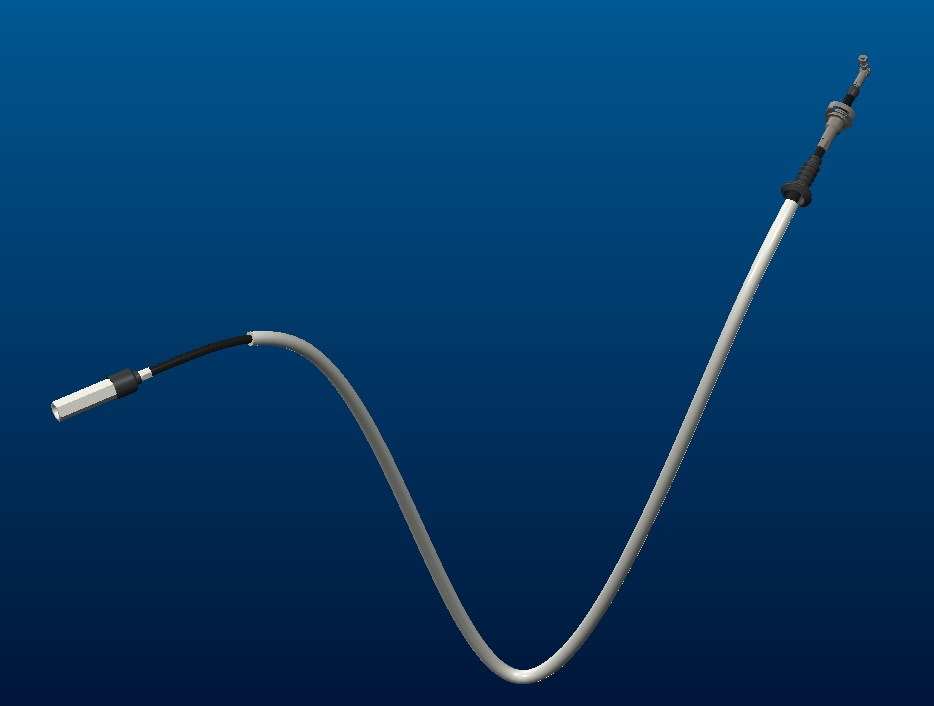Community Tip - Did you get an answer that solved your problem? Please mark it as an Accepted Solution so others with the same problem can find the answer easily. X
- Community
- Creo+ and Creo Parametric
- 3D Part & Assembly Design
- Re: FIXED LENGHT OF DATUM CURVE
- Subscribe to RSS Feed
- Mark Topic as New
- Mark Topic as Read
- Float this Topic for Current User
- Bookmark
- Subscribe
- Mute
- Printer Friendly Page
FIXED LENGHT OF DATUM CURVE
- Mark as New
- Bookmark
- Subscribe
- Mute
- Subscribe to RSS Feed
- Permalink
- Notify Moderator
FIXED LENGHT OF DATUM CURVE
hello everybody,
is it possible to set a relation in which fix lenght od datum curve?
thanks
Solved! Go to Solution.
- Labels:
-
General
- Tags:
- creo-parametric
Accepted Solutions
- Mark as New
- Bookmark
- Subscribe
- Mute
- Subscribe to RSS Feed
- Permalink
- Notify Moderator
No. And the reason is that the flex of the cable is a deformation relaxation optimization problem** that depends on the flexibility of the cable and the end conditions, which is far above the capability of a parametric modeler.
What most people do is look at the installed length of the cable and use that value to drive the straight length so they part as-procured will be long enough to be installed. You also need to verify that the curvature of the cable isn't higher than allowed (or the radius smaller, depending on your viewpoint) and, if that's a push-pull cable, that the path doesn't create too much internal friction due to the routing. While the curvature can be checked, the friction is beyond the parametric modeler to determine.
**you would be looking for the case of minimum strain energy stored in the cable in both tension and torsion, which is where the end conditions can have a big influence.
- Mark as New
- Bookmark
- Subscribe
- Mute
- Subscribe to RSS Feed
- Permalink
- Notify Moderator
Only straight ones by managing the nodes used to create the curve.
Technically, the answer to your question is no.
Datum curves try to follow your selections.
It doesn't do sharp corners unless you specifically make the segments straight.
If you have only straight segments, you can do the math on the selected references instead.
In other words, you have to reverse engineer the curve's length regardless.
- Mark as New
- Bookmark
- Subscribe
- Mute
- Subscribe to RSS Feed
- Permalink
- Notify Moderator
...curious to know, however:
What if you create your curve; measure it's length (measure feature); and scale the part between the current length and the desired length(?)
- Mark as New
- Bookmark
- Subscribe
- Mute
- Subscribe to RSS Feed
- Permalink
- Notify Moderator
I did something like that to simulate a bent flat spring. There's an equation for cantilever beams that gives the curve based on the load, but it assumes the deflection is very small so it doesn't account for the rotation of the beam elements.
As an exercise I wanted to use it for larger deflections, so I first created the uncorrected curve, then used a measure of its length to create a corrected curve with a shorter X-direction length to make up for Y-direction deflection. I ended up using a series of 3 iterations of curves to get one that ended up matching the finished length to the original length within a small amount.
I took a real part and compared the fudged curve and it was very close, close enough to match the initial installed position of the steel strip.
The main thing I wanted after that was for Relations to support user defined functions, but I suppose those and loops aren't coming any time soon.
- Mark as New
- Bookmark
- Subscribe
- Mute
- Subscribe to RSS Feed
- Permalink
- Notify Moderator
did you mean scale all or only the curve?
- Mark as New
- Bookmark
- Subscribe
- Mute
- Subscribe to RSS Feed
- Permalink
- Notify Moderator
I was thinking scaling the entire part.
- Mark as New
- Bookmark
- Subscribe
- Mute
- Subscribe to RSS Feed
- Permalink
- Notify Moderator
for example, i have the cable straight in the picture below

but if i put it in an assembly and mount it the lenght changes

so i wanted to know if there is a relation to write in order to measure the lenght of curve and make it close to the real lenght
thanks
- Mark as New
- Bookmark
- Subscribe
- Mute
- Subscribe to RSS Feed
- Permalink
- Notify Moderator
No. And the reason is that the flex of the cable is a deformation relaxation optimization problem** that depends on the flexibility of the cable and the end conditions, which is far above the capability of a parametric modeler.
What most people do is look at the installed length of the cable and use that value to drive the straight length so they part as-procured will be long enough to be installed. You also need to verify that the curvature of the cable isn't higher than allowed (or the radius smaller, depending on your viewpoint) and, if that's a push-pull cable, that the path doesn't create too much internal friction due to the routing. While the curvature can be checked, the friction is beyond the parametric modeler to determine.
**you would be looking for the case of minimum strain energy stored in the cable in both tension and torsion, which is where the end conditions can have a big influence.





